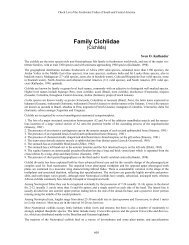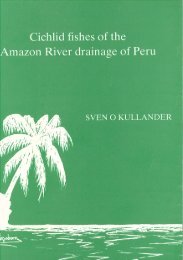Open Access PDF - Sven Kullander
Open Access PDF - Sven Kullander
Open Access PDF - Sven Kullander
You also want an ePaper? Increase the reach of your titles
YUMPU automatically turns print PDFs into web optimized ePapers that Google loves.
ion; belly lighter than the other parts of the body.”<br />
(Jardine, 1843: 145).<br />
The description of C. trifasciata derives mainly<br />
from a drawing provided by Schomburgk. The<br />
local appellation provided, Lucanari Grande, is<br />
a Guyanese-Spanish mix, and not likely to derive<br />
from the Brazilian portion of Rio Negro, where<br />
the corresponding Tupi-Guarani would have been<br />
Tucunaré-açu. Nonetheless, the drawing (Jardine<br />
1843: pl. 9) shows a fish clearly referable to<br />
C. temensis. It is apparently a breeding male as it<br />
features a small but distinct hump. The body is<br />
greenish, with grey dorsum, three wide dark<br />
vertical bars, black spots on the head side apparently<br />
representing the postorbital stripe and associated<br />
spots on the gill cover, but no yellow<br />
spots or lines on the side. Lower fins, iris and<br />
branchiostegal membrane are painted dull or<br />
bright red.<br />
Heckel’s Cichla tucunare is based on a stuffed<br />
specimen 2 feet long from Rio Branco, probably<br />
more precisely Forte do Rio-branco (= Forte or<br />
Fortaleza de São Joaquim, near Boa Vista), where<br />
the local name was recorded (Heckel, 1840: 409).<br />
The holotype cannot now be located, but the<br />
description agrees very well with C. temensis.<br />
Cichla tucunare is diagnosed as having continuous<br />
lateral line and 110-120 scales; three vertical bars<br />
on the side, a narrow postorbital stripe, a caudal<br />
ocellus and rows of milky white spots behind the<br />
caudal ocellus. Heckel also mentions traces of<br />
yellowish spots on the body and dorsal fin.<br />
Heckel (1840: 413) apparently also had one or<br />
more specimens of C. temensis from Rio Negro,<br />
but those were smaller specimens (13 inches TL)<br />
showing characteristic rows of light spots along<br />
the side.<br />
The description of Cichla unitaeniatus Magalhães<br />
(1931) may have been unintentional, and is<br />
not so precise as to permit unequivocal identification<br />
of the species. It is contained in a note<br />
headed “Nota: TUCUNARÉ-SUBIANA – Chichla<br />
uitaeniatus, ? – Rio Negro” (corrected in the<br />
errata to tucunaré sorubiana, Cichla unitaeniatus).<br />
Magalhães never observed a specimen, but describes<br />
the species on characters supplied by<br />
“credible persons”: “Whitish tucunaré with a dark<br />
band along the lateral line; this band starting a<br />
little behind the gill opening and runs to the base<br />
of the caudal fin, forming a slight curve”. The<br />
species is further said to be the largest tucunaré<br />
species in the Negro and Purús, attaining 80 cm<br />
total length, but is not as common as C. ocellaris.<br />
Ichthyol. Explor. Freshwaters, Vol. 17, No. 4<br />
381<br />
Given the distribution, the large size, the name<br />
sorubiana (cf. sarabiana of Natterer), and the<br />
compatible colour pattern (typical of young<br />
C. temensis only), it seems likely that the description<br />
refers to C. temensis and not to any other<br />
Mid-Amazonian species of Cichla. However, at<br />
commercial sizes none of the Cichla species would<br />
show a horizontal stripe as described by Magalhães.<br />
Steindachner (1883: 3, pl. 1 fig. 3), reports a<br />
26 cm SL specimen of C. temensis from Iquitos in<br />
Peru said to have 95 scales along the side, and<br />
provided a figure stated to show a juvenile<br />
specimen. He also reports a 22 cm SL specimen<br />
of C. ocellaris from the Rio Huallaga, but illustrats<br />
the species with a juvenile (1883: 3, pl. 1 fig. 2).<br />
The figure of C. temensis shows a juvenile C. temensis<br />
or possibly C. pinima, whereas the figure of<br />
C. ocellaris shows a young C. orinocensis. The illustrations<br />
apparently do not show Peruvian<br />
specimens, but are probably based on material<br />
from the Thayer Expedition, traveling only within<br />
Brazil, from which specimens of C. temensis<br />
and C. orinocensis were deposited in NMW. Steindachner<br />
(1883: 3) states that he would provide<br />
detailed descriptions of the variability within<br />
C. ocellaris in the second part of his paper on<br />
Amazonian cichlids. The first part (Steindachner,<br />
1875) dealt almost exclusively with Thayer Expedition<br />
material. This second part, however, was<br />
never published. The Peruvian Cichla specimens<br />
were deposited in the Museum für Tierkunde,<br />
Dresden. The C. temensis specimen was discarded<br />
in 1909, and the C. ocellaris specimen was identified<br />
by <strong>Kullander</strong> (1986: 60), as a probable C. monoculus.<br />
Although C. temensis may be the largest species<br />
of Cichla, and consequently the largest species<br />
of cichlid in South America, precise measurements<br />
of large specimens are scarce, and it is not always<br />
documented whether lengths are standard or<br />
total lengths. There appear to be no really large<br />
specimens in museum collections. The sport fishing<br />
weight record is 27 lbs (12.25 kg) (IGFA data<br />
at http://www.peacockbassassociation.com/).<br />
Jepsen et al. (1999) reported a maximum length<br />
of 750 mm SL and maximum weight of 9.2 kg in<br />
C. temensis from the upper Rio Negro. Winemiller<br />
(2001: p. 98) gives maximum sizes 810 mm<br />
SL in rivers and 621 mm SL in reservoirs in Venezuela.<br />
Román (1981: 83) has a photo of a 710 mm<br />
SL specimen. Other species of Cichla generally do<br />
not exceed 500 mm in SL, and rarely more than




